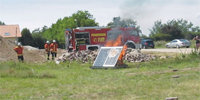Photovoltaic array fire test

Photovoltaic fires in conjunction with electrical hazards are often discussed today. As photovoltaic (PV) arrays may produce electric tension up to 1000 Volt still present in case of fire, very often, the question is whether to extinguish the fire or to let the building burn down in a controlled way.
In order to find out what hazards may arise from such fires, a German PV producer and the fire brigade carried out a fire test on a PV array. Around 300 people and several delegations of local fire brigades attended this event on Saturday, July 16th, 2011, in Hockenheim, Germany.
The PV array was set on fire and monitored with a specific instrumentation to find out what happens when the flames impinge on the PV modules. During the test, electric tension, power, peak output power, temperature, irradiation intensity and insulation resistance were monitored.
As long as the PV modules are not damaged by the fire, they are safe. The modules are designed to national and international standards for preventing electrical shock in case of contact.
In case of fire, i.e. after impingement of the flames on the modules, higher tension only occurs for a short period of time: after one minute, the tension had already decreased by 50 %; after two minutes, there was no tension anymore. The insulation resistance was measured with a test tension of 1000 V; after 30 s an insulation malfunction occurred, which may immediately lead to 0 V tension for earthed arrays. When flame propagation takes place on the modules, there is only a very short period of time where the hazardous tension is no more protected. Here, there are explicit fire brigade directives requesting a minimum fire fighting distance of 1 m for spray jet and 5 m for full jet, in order to avoid an electrical shock.
If in a domestic fire the modules are not damaged by the fire and still produce the hazardous voltage, the PV array is to be treated the same way as a domestic electrical installation in case of fire. Basically, in domestic electrical installations, peak tensions of 510 to 620 V may occur, while the peak tensions of PV arrays are typically at 400 to 800 V at high irradiation level (clear day sky).
Even for domestic fires without PV arrays it is not always possible to switch off the domestic electrical installation and the fire brigade must be aware of hazardous tension all over the house and comply with the same safety requirements and minimum distances during fire fighting as for PV arrays.
The test has shown that when complying with the fire brigade guidelines no unusual hazards arise from PV arrays in case of fire.
More details (in German): http://www.etsp.de/index.php?option=com_content&view=article&id=156%3averanstaltung-brand-photovoltaikanlage&catid=1%3aaktuelle-nachrichten&lang=de/